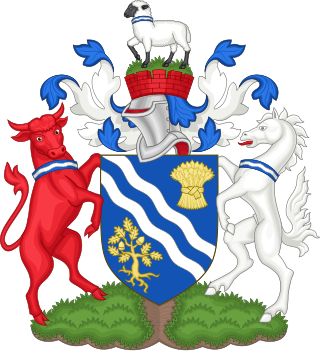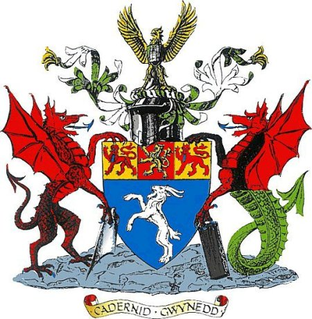Related Research Articles

Merionethshire or Merioneth is one of thirteen historic counties of Wales, a vice county and a former administrative county.

Montgomeryshire is one of thirteen historic counties and a former administrative county of Wales. It is named after its county town, Montgomery, which in turn is named after one of William the Conqueror's main counsellors, Roger de Montgomerie, who was the 1st Earl of Shrewsbury.

Meirionnydd is a coastal and mountainous region of Wales. It has been a kingdom, a cantref, a district and, as Merionethshire, a county.

Oxfordshire County Council is the county council for the non-metropolitan county of Oxfordshire in the South East of England. Established in 1889, it is an elected body responsible for most strategic local government services in the county.

Hertfordshire County Council is the upper-tier local authority for the non-metropolitan county of Hertfordshire, in England. The council was created in 1889. It is responsible for a wide range of public services in the county, including social care, transport, education, and the Hertfordshire Fire and Rescue Service. The Conservatives have held a majority of the seats on the council since 1999. The council is based at County Hall in Hertford.

Somerset Council, known until 1 April 2023 as Somerset County Council, is the unitary authority which governs the district of Somerset, which occupies the southern part of the ceremonial county of the same name in the South West of England. The council has been controlled by the Liberal Democrats since the 2022 local elections, and its headquarters is County Hall in Taunton.

Cardiff Council, formally the County Council of the City and County of Cardiff is the governing body for Cardiff, one of the Principal Areas of Wales. The principal area and its council were established in 1996 to replace the previous Cardiff City Council which had been a lower-tier authority within South Glamorgan. Cardiff Council consists of 79 councillors, representing 28 electoral wards.

Gwynedd Council, which styles itself by its Welsh name Cyngor Gwynedd, is the governing body for the county of Gwynedd, one of the principal areas of Wales. The council administrates internally using the Welsh language.

Ceredigion County Council is the governing body for the county of Ceredigion, since 1996 one of the unitary authorities of Wales. The council's main offices are in Aberaeron.

Essex County Council is the county council that governs the non-metropolitan county of Essex in England. It has 75 councillors, elected from 70 divisions, and has been under Conservative majority control since 2001. The council meets at County Hall in the centre of Chelmsford. It is a member of the East of England Local Government Association.

Wiltshire Council, known between 1889 and 2009 as Wiltshire County Council, is a unitary authority which governs the district of Wiltshire, which covers the majority of the ceremonial county of the same name in South West England. The council has been controlled by the Conservative Party since 2000, and has its headquarters at County Hall in Trowbridge.
Cardiganshire County Council was the local government authority for the county of Cardiganshire, Wales, between 1889 and 1974. It was superseded by Dyfed County Council.

Cumbria County Council was the county council for the non-metropolitan county of Cumbria in the North West of England. Established in April 1974, following its first elections held the previous year, it was an elected local government body responsible for the most significant local services in the area, including schools, roads, and social services.

Cumberland County Council was the county council of Cumberland in the North West of England, an elected local government body responsible for most local services in the county. It was established in 1889 as a result of the Local Government Act 1888. Carlisle was initially within its area but became a separate county borough in 1914. In 1974, both authorities were merged along with parts of others into the new Cumbria County Council. In April 2023 local government in Cumbria was reorganised into two unitary authorities, one of which is named Cumberland Council and includes most of the historic county, with the exception of Penrith and the surrounding area.
The first election to the Glamorgan County Council was held on 17 January 1889. Results were announced over several days. They were followed by the 1892 election. The authority, by far the largest county in Wales in terms of population, was established by the 1888 Local Government Act. The county of Glamorgan was at this time becoming heavily industrialised although some areas such as the Vale of Glamorgan remained essentially rural.
The second election to the Glamorgan County Council was held on 8 March 1892. The 1889 election was the first contest and the next was the 1895 election. Glamorgan County Council had been established by the 1888 Local Government Act, and the first election held in January 1889. Glamorgan was by far the largest county in Wales in terms of population. The county of Glamorgan was at this time becoming heavily industrialised, although some areas such as the Vale of Glamorgan remained essentially rural. The rise of nonconformist liberalism, especially since the 1860s, throughout Wales, had challenged the prevailing influence of the landed gentry. However, even in 1889, the traditional forces remained influential and no working men were elected to the council. This changed in 1892 with the unopposed return of David Morgan in Aberdare and the success of Isaac Evans in Resolven.

The first Pembrokeshire County Council was established in 1889 under the Local Government Act 1888, to govern the administrative county of Pembrokeshire. This first county council was abolished in 1974 under the Local Government Act 1972.
The first election to the Merionethshire County Council was held on 18 January 1889. It was followed by the 1892 election. The county was divided into numerous single member wards with two councillors elected to represent some of the urban areas.
The second election to the Merionethshire County Council was held in March 1892. They were preceded by the 1889 election and followed by the 1895 election.

William Robert Maurice Wynne of Peniarth, Merionethshire, often referred to as W.R.M. Wynne, was a Conservative politician and prominent landowner who also made a notable contribution to the cultural life of Wales by donating the Peniarth Manuscripts to the National Library of Wales, Aberystwyth. Wynne also served as Conservative MP for Merioneth from 1865 to 1868. He stood down in 1868 when facing likely defeat by the Liberal candidate David Williams, following the Second Reform Act.
References
- ↑ "The Welsh Language and the County Councils (editorial)". Cambrian News. 8 February 1889. p. 4. Retrieved 16 July 2015.
- ↑ "Merioneth County Council". Cambrian News. 8 March 1889. p. 6. Retrieved 20 July 2015.